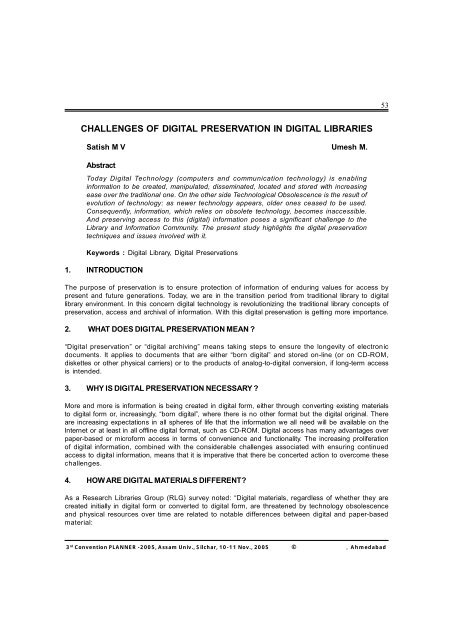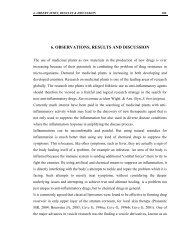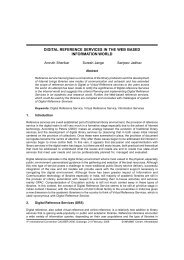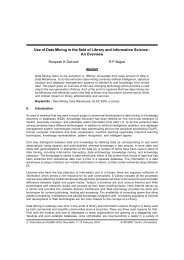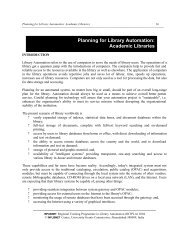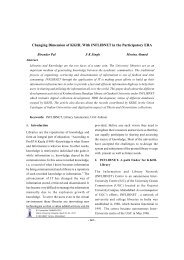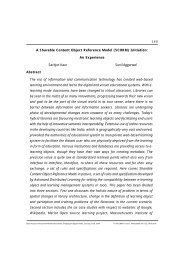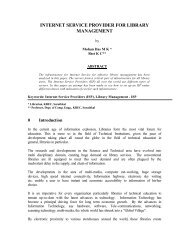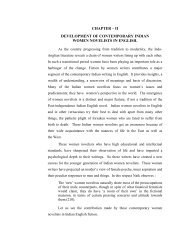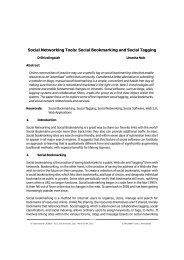CHALLENGES OF DIGITAL PRESERVATION IN DIGITAL LIBRARIES
CHALLENGES OF DIGITAL PRESERVATION IN DIGITAL LIBRARIES
CHALLENGES OF DIGITAL PRESERVATION IN DIGITAL LIBRARIES
You also want an ePaper? Increase the reach of your titles
YUMPU automatically turns print PDFs into web optimized ePapers that Google loves.
53<strong>CHALLENGES</strong> <strong>OF</strong> <strong>DIGITAL</strong> <strong>PRESERVATION</strong> <strong>IN</strong> <strong>DIGITAL</strong> <strong>LIBRARIES</strong>Satish M V Umesh M.AbstractToday Digital Technology (computers and communication technology) is enablinginformation to be created, manipulated, disseminated, located and stored with increasingease over the traditional one. On the other side Technological Obsolescence is the result ofevolution of technology: as newer technology appears, older ones ceased to be used.Consequently, information, which relies on obsolete technology, becomes inaccessible.And preserving access to this (digital) information poses a significant challenge to theLibrary and Information Community. The present study highlights the digital preservationtechniques and issues involved with it.Keywords : Digital Library, Digital Preservations1. <strong>IN</strong>TRODUCTIONThe purpose of preservation is to ensure protection of information of enduring values for access bypresent and future generations. Today, we are in the transition period from traditional library to digitallibrary environment. In this concern digital technology is revolutionizing the traditional library concepts ofpreservation, access and archival of information. With this digital preservation is getting more importance.2. WHAT DOES <strong>DIGITAL</strong> <strong>PRESERVATION</strong> MEAN ?“Digital preservation” or “digital archiving” means taking steps to ensure the longevity of electronicdocuments. It applies to documents that are either “born digital” and stored on-line (or on CD-ROM,diskettes or other physical carriers) or to the products of analog-to-digital conversion, if long-term accessis intended.3. WHY IS <strong>DIGITAL</strong> <strong>PRESERVATION</strong> NECESSARY ?More and more is information is being created in digital form, either through converting existing materialsto digital form or, increasingly, “born digital”, where there is no other format but the digital original. Thereare increasing expectations in all spheres of life that the information we all need will be available on theInternet or at least in all offline digital format, such as CD-ROM. Digital access has many advantages overpaper-based or microform access in terms of convenience and functionality. The increasing proliferationof digital information, combined with the considerable challenges associated with ensuring continuedaccess to digital information, means that it is imperative that there be concerted action to overcome thesechallenges.4. HOW ARE <strong>DIGITAL</strong> MATERIALS DIFFERENT?As a Research Libraries Group (RLG) survey noted: “Digital materials, regardless of whether they arecreated initially in digital form or converted to digital form, are threatened by technology obsolescenceand physical resources over time are related to notable differences between digital and paper-basedmaterial:3 rd Convention PLANNER -2005, Assam Univ., Silchar, 10-11 Nov., 2005 © , Ahmedabad
• Machine Dependency. Digital materials all require specific hardware and software in order toaccess them.• The speed of changes in technology means that the timeframe during which action must be takenis very much shorter than for paper-timeframes during which action needs to be taken is measuredin a few years, perhaps only 2-5, as opposed to decades or even centuries we associate with thepreservation of traditional materials. Technology obsolescence is generally regarded as thegreatest technical threat to ensuring continued access to digital material.• Fragility of the media. The medial digital materials are stored on is inherently unstable and withoutsuitable storage conditions and management can deteriorate very quickly even though it may notappear to be damaged externally.• The ease with which changes can be made and the need to make some changes in order tomanage the material means that there are challenges associated with ensuring the continuedintegrity, authenticity, and history of digital materials.• The implications of allocating priorities are much more severe than for paper. A digital resource,which is not selected for active preservation treatment at an early stage will very likely be lost orunusable in the near future.• The nature of the technology requires a life-cycle management approach to be taken to itsmaintenance. A continual programme of active management is needed from the design andcreation stage if preservation is to be successful. This in turn leads to much more involvementboth within and between institutions and changing roles.5. ISSUES IDENTIFIED WITH <strong>DIGITAL</strong> <strong>PRESERVATION</strong> (DP)There are number of issues involved in the preservation of digital objects.54Issues/Challenges identified with DPTechnologicalLegal IssuesDigital MediaChallenges in TechnologyAuthenticity & ContextScalePreservation StrategiesOrganisationalIssuesCostStaff ExpertiseRole & ResponsibilitySelectionLegal IssuesIPR & PreservationAccess & SecurityPrivacy & ConfidentialityBusiness Model &Licensing
555.1 Technological Issuesi. Digital media“Digital materials are especially vulnerable to loss and destruction because they are stored on fragilemagnetic and optical media that deteriorate rapidly and that can fail suddenly from exposure to heat,humidity, airborne contaminants, or faulty reading and writing devices.”Precautions can be taken which will help significantly to reduce the danger of loss and include:• Storing in a stable, controlled environment.• Implementing regular refreshment cycles to copy onto newer media.• Making preservation copies (assuming licensing/copyright permission).• Implementing appropriate handling procedures.• Transferring to “standard” storage media.However, while the media on which the information are stored may or may not fail, what is certain is thattechnology will change rapidly so that even if the media is retained in pristine condition, it may still not bepossible to access the information it contains. No matter how exemplary the care of the media is, it willnot remove the requirement to deal with changes in technology, though responsible care should make iteasier to manage technology changes.ii.Changes in technology“Unlike the situation that applies to books, digital archiving requires relatively frequent investments toovercome rapid obsolescence introduced by galloping technological change.”Because digital material is machine dependent, it is not possible to access the information unless thereis appropriate hardware, and associated software which will make it intelligible. Technology advanceseven in the past decade illustrate this point:• 5 1 / inch floppy disks have been superseded by 3 1 / inch floppy disks;4 2• There have been several upgrades to Windows software since it was first introduced and it wouldnow be very difficult to convert from earlier versions to the current versions;• Thousands of software programs common in the early 1990s are now extinct and unavailable.RLG survey cited technological obsolescence as the greatest threat to successful digital preservation.Precautions can, and should be taken, which will greatly reduce the risk of inadvertently losing access toa resource because of changes in technology. These include:• Using standard file and media formats, as recommended by reputable sources.• Providing detailed documentation (covers Metadata) to enable both contexts to be determined andalso to facilitate successful management.iii.Authenticity and context“At each stage of the cycle, electronic records need to be actively managed according to establishedprocedures, to ensure that they retain qualities of integrity, authenticity and reliability.”
For example, scholars will need to feel confident that references they cite will stay the same over time,courts of law will need to be assured that material can withstand legal evidential requirements, governmentdepartments may well have legally enforceable requirements regarding authenticity, and so on.56iv.ScaleAlthough computer storage is increasing in scale and its relative cost is decreasing constantly, thequantity of data and our ability to capture it with relative ease still matches or exceeds it in a number ofareas. Some repositories still face significant challenges in developing and maintaining scaleablearchitectures and procedures to handle huge quantities of data generated from sources such as satellitesor the web. The technical and managerial challenges in accessioning, managing and providing accessto digital materials on this scale should not be underestimated.v. Preservation StrategiesSeveral strategies attempt to address the primary digital preservation problem of technologicalobsolescence. These include migrating information through successive generations of technology, usingsoftware to emulate the behaviour of older machines, preserving original hardware and software to runobsolete programs, and creating hard copies (paper or microform) of digital objects. Each of thesestrategies meets some, but not all, preservation goals. And choice of strategy will depend upon thenature of the material and what aspects are to be retained.a) MigrationMigration is the primary strategy articulated by most organizations that plan to preserve digital objects. Itcovers a range of activities to periodically copy, convert or transfer digital information from one generationof technology to subsequent ones, i.e. it ensures that the digital information is re-encoded in new formatsbefore the old format becomes obsolete. Migration may involve copying digital information from a mediumthat is becoming obsolete or physically deteriorating to newer one (e.g. floppy to CD-ROM) and convertingfrom one format to another (Microsoft Word to ASCII). Migration certainly preserves the physical presenceand the content of digital object. However, it may not preserve preservation, functionality and context. Forexample, presentation elements such as bolding and italics may disappear, and functionality and contextprovided by links between databases entries may be lost because the links break. Successive migrationsmay eventually result in unacceptable data loss.There are a number of ways to increase the chances of using migration successfully as preservationstrategy. These include:• Capturing the context by documenting hardware and software required to access digital objects(and ensuring the technology is subsequently available).• Monitoring backward compatibility of software to determine when to migrate.• Choosing a small number of standard formats and converting non-standard formats to standardones to minimize the amount of conversion required.b) EmulationEmulation refers to creating new software that mimics the operations of older hardware or software inorder to reproduce its performance. Thus, not only are physical presence and content preserved, but
digital objects could display original features (e.g. layout) and functionality available with the older software.Emulation has recently attracted attentions as a potential strategy to assist preservation, recognizing thatsome electronic material that is highly dependent on particular hardware and software will not lend itselfto migration.One of the benefits of the emulation strategy compared with migration is that the original data need notbe altered in any way. It is the emulation of the computer environment that will change with time. Thisshould help maintain the integrity and “look and feel” of the material. Another advantage of implementingemulation is its possible efficiency. Once the data is archived with appropriate metadata and software, noother action is required apart from media refreshing until access is desired. One emulator can also beused as a solution for several data objects requiring the same operating environment.c) Output to permanent paper or microformOutputting a hard copy of a digital file is a “low tech” solution that can result in a well-standardized productwith a life expectancy of several hundred years. Certainly, this strategy could fix the object as a whole andpreserve content and to some extent layout. However, a decreasing number of publications (flat files,printable formats) lend themselves to such methods. For example, output to paper will lead to greatfunctional loss for hypertext documents, and cannot capture multimedia. Despite these drawbacks, a“hybrid strategy” of creating both microfilm and digital copies is gaining support as a technique forreformatting paper originals. The digital copy enhances access and functionality, and the microform copyacts as an archival surrogate.d) Technology preservationAnother method for ensuring ongoing access to digital objects would be to simply keep older technologyavailable for use. Although this would preserve content and enable future generations to view digitalobjects in their native format with original layout and functionality, creating hardware or software “museums”is prohibitive in cost, space and technical support requirements. At best this method is an interim measurewhen migration is not possible.5.2 Organisational IssuesWhile technological issues are undeniably challenging, there are also numerous challenges, whichrelate to the ability of organisations to integrate the management of digital materials into their organisationalstructure. In addition, there is an increasing need to go beyond the confines of individual organisations,or even countries, to maximise the benefits of the technology, address issues such as copyright, andalso to overcome the challenges cost-effectively The following issues are being faced, and in manycases, systematically addressed, by organisations world-wide.i. Costs“Part of the difficulty in understanding costs has been the lack of working examples from which to learnand the difficulty in extrapolating costs from pilot projects (of which there have been many) to full-scalepublic services.”As the above quote illustrates, there is a wide and potentially misleading amount of project-related dataon costs which may or may not have any bearing on the costs of managing digital materials long-term. Itis important to differentiate costs for digitization, for which there are more reliable cost models (thoughstill needing to be interpreted with care), from the costs of managing digital materials, whether thosematerials are produced as a result of digitizing analogue materials or whether they are “born digital”.57
Expertise, the ability to employ and develop staff with appropriate skills is made more difficult by thespeed of technological change and the range of skills needed. It is also limited by resource constraintson organisations which may well need to retain the same level of ongoing commitment to and managementof traditional collections and may need to integrate commitment to digital collections without additionalresources.Because costs for both technical and organisational infrastructure are still not well defined organisationsare confronted with the requirement to commit to the principle to safeguard significant digital assets,without a clear idea of the associated costs over time. This makes forward planning a somewhat morehazardous activity and one in which organisations need to begin to take action but may be unwilling to doso without more concrete assurances of costs. This requires faith that cost-effective solutions are morelikely to emerge once organisations have sufficient practical experience in managing digital collections.This experience is also likely greatly to improve the prospects for effective collaboration, which is basedon a shared understanding of the practicalities involved. An approach which builds incrementally onpractice within the institution and collaboration with others who are confronting the same challenges willreduce risk and help develop effective strategies and practices.58ii.ExpertiseThe dramatic speed of technological change means that few organisations have been able even fully toarticulate what their needs are in this area, much less employ or develop staff with appropriate skills. Inaddition, there is little in the way of appropriate training and “learning by doing” can often be the mostpractical interim measure. Continuous professional development will be at least as necessary for dealingwith digital materials as it is for other developmental needs.iii.Organisational structures“In addition to redefining responsibilities of organisations, it may be necessary to redefine roles withinorganisations to ensure long-term access to digital information.” (PADI)The nature of the technology and dependencies in the preservation of digital materials are such thatthere are implications for organisational structures. Organisational structures tend to be segregated intodiscrete elements for the efficient processing of traditional collections, but will need to cross boundariesin order to draw on the full range of skills and expertise required for digital materialsiv.Roles and Responsibilities“Although there is continuity of purpose and value within cultural institutions, these exist alongside afundamental examination of roles and practices.”There are some existing repositories which undertake responsibility for specific subject areas or specificformats. In the UK, for example, the Arts and Humanities Data Service and Data Archive are two examplesof institutions undertaking responsibility for social science and humanities research data, while theNational Sound Archive assumes responsibility for its collection of sound recordings. In addition, there iswork going on in other countries to establish national co-operative models for digital preservation. Intime, it is expected that these efforts in individual countries will crystallise into clearly defined roles andresponsibilities where it is as obvious which institution is likely to be the major preserver of specificdigital materials as it is for non digital materials. Despite these encouraging developments, at thepresent time the question of who should be responsible for ensuring long-term preservation is by nomeans as established in the digital environment as it is in the analogue environment.
Even when it has been determined which organisations will undertake to act on their long-term digitalpreservation responsibilities the environment will demand far greater engagement with a much largergroup of stakeholders than has previously been the case. Some will inevitably choose to contract out allor part of their digital preservation responsibilities to a third party provider. The lifecycle approach advocatedby Beagrie and Greenstein has significant implications for the way organisations responsible for longtermpreservation need to interact and collaborate with data producers and publishers and each other.Roles are also changing within as well as between institutions. Assigning responsibility for preservationof digital materials acquired and/or created by an organisation will inevitably require involvement withpersonnel from different parts of the organisation working together. This can potentially present difficultiesunless underpinned by a strong corporate vision which can be communicated to staff. Similarly, staffworking in an increasingly electronic environment are needing to modify their role to reflect the differentdemands of the technology.Finally, creators of digital materials need to be able to understand the implications of their actions interms of the medium to long-term viability of the digital material they create. Whether it be a record createdduring the day-to-day business of the department, a digital copy of analogue collection material, or a“born digital” resource, guidance and support as well as an appropriate technical and organisationalinfrastructure will assist in facilitating greatly improved prospects for efficient management andpreservation.59iv.Selection“In the network environment, any individual with access to the Internet can be a publisher and the networkpublishing process does not always provide the initial screening and selection at the manuscript stageon which libraries have traditionally relied in the print environment.” (National Library of Canada 1998)The enormous quantity of information being produced digitally, its variable quality, and the resourceconstraints on those taking responsibility to preserve long-term access, makes selectivity inevitable ifthe objective is to preserve ongoing access. In the digital environment, it is possible to by-pass thetraditional distribution channels, as well as filtering and quality control processes. While there are benefitsfor users in terms of swift access, there are also difficulties in terms of quality control. Selecting qualitymaterials for long-term retention therefore places a burden on organisations in terms of resources andalso in terms of the potential impact of selection.With traditional collections, lack of selection for preservation may not necessarily mean that the item willbe lost, allowing for a comfort zone of potential changes in criteria for selection at a later stage. No suchcomfort zone exists in the digital environment where non-selection for preservation will almost certainlymean loss of the item, even if it is subsequently considered to be worthwhile.In cases where there may be multiple versions, decisions must be made in selecting which version isthe best one for preservation, or whether more than one should be selected. Sampling dynamic resourcesas opposed to attempting to save each change, may be the only practical option but may have severerepercussions if the sampling is not undertaken within a well-defined framework and with due regard tothe anticipated contemporary and future needs of the users.Some consideration also needs to be given in the selection to the level of redundancy needed to ensuredigital preservation. A level of redundancy with multiple copies held in different repositories is inherent intraditional print materials and has contributed to their preservation over centuries. Although in a digitalenvironment a single institution can provide worldwide access and accept preservation responsibility, itremains an issue of concern to many that a level of redundancy should exist in the digital environment.
Such concerns need to be balanced against the potential cost in duplication of effort. Either scenariopoints to a greater level of overt collaboration in selection between institutions to preserve electronicpublications. In any scenario, it will be critical to establish sustainability and unequivocal acceptance ofresponsibility to avoid the danger of losing access over time. There still needs to be assurance thatpreservation responsibility will be undertaken, and a clear understanding of who will undertake thatresponsibility and for what period of time. Otherwise there can be no guarantee that, even if severalcopies are stored in various repositories, all of those repositories might, for a variety of reasons, ceasemaintenance of the digital object at some point.Finally, in all successful preservation strategies it may well be necessary to repeat steps in the selectionprocess, with appropriate documentation, as part of the long-term cycle of actions to maintain access innew technological environments.5.3 Legal IssuesCompounding the technical challenges of migrating digital information is the problem of managing theprocess in a legal and organizational environment that is in flux as it moves to accommodate rapidlychanging digital technologies.” (Waters and Garrett 1996)i. Intellectual property rights (IPR) and preservation:Copyright and other intellectual property rights (IPR) such as moral rights have a substantial impact ondigital preservation. As outlined in Technological Issues the preservation of digital materials is dependenton a range of strategies, which has implications for IPR in those materials. The IPR issues in digitalmaterials are arguably more complex and significant than for traditional media and if not addressed canimpede or even prevent preservation activities. Consideration may need to be given not only to contentbut to any associated software. Simply copying (refreshing) digital materials onto another medium,encapsulating content and software for emulation, or migrating content to new hardware and software,all involve activities which can infringe IPR unless statutory exemptions exist or specific permissionshave been obtained from rights holders.As both migration and emulation will involve manipulation and changing presentation and functionality tosome degree (especially over any period of time) important issues of principle and practice are raised innegotiations. It is important to establish a dialogue with rights holders so that they are fully aware ofthese issues and the actions and rights required to ensure the preservation of selected items.What is different about IPR and electronic materials?Traditional materials are relatively stable and well-established legal and organisational frameworks forpreservation are in place. This is not the case for electronic materials. Digital materials need considerationof both content and also hardware and software, and require very different methods of preservationThe duration of IPR in electronic materials will often extend well beyond commercial interests in themand the technology, which was used to generate them. Long-term preservation and access may requiremigration of the material into new forms or emulation of the original operating environment: all of whichmay be impossible without appropriate legal permissions from the original rights owners of the contentand underlying software.60
61ii.Access and securitySome of the additional complexity in IPR issues relates to the fact that electronic materials are also easilycopied and re-distributed. Rights holders are therefore particularly concerned with controlling accessand potential infringements of copyright. Technology developed to address these concerns and providecopyright measures can also inhibit or prevent actions needed for preservation. These concerns overaccess and infringement and preservation need to be understood by organisations preserving digitalmaterials and addressed by both parties in negotiating rights and procedures for preservation.iii.Business models and licensingConsideration of the business models for dissemination of electronic materials and the range ofstakeholders also impacts on IPR and preservation. In most cases electronic publications (particularlyelectronic journals) are not physically owned by the subscribers, who license access from the publisher.Subscribers are therefore concerned that publishers consider the archiving and preservation of theseworks and include archiving and perpetual access to back issues in licensing of these works.iv.Stakeholders, contract and grant conditions, and moral rightsElectronic materials are the result of substantial financial investment by public funds (e.g. researchcouncils) and/or publishers and intellectual investment by individual scholars and authors. Each ofthese stakeholders may have an interest in preservation; the archiving organisation will need to acquirepermissions from them to safeguard and maximise the financial investment or the intellectual andcultural value of the work for future generations. Such interests may be manifested through contract,licence, and grant conditions or through statutory provision such as “moral rights” for the authors.v. Privacy and confidentialityInformation held within the repository may be subject to the Data Protection Act or similar privacy legislationprotecting information held on individuals. Information may also be subject to confidentiality agreements.Privacy and confidentiality concerns may impact on how digital materials can be managed within therepository or by third parties, and made accessible for use.vi.Investment in deposited materials by the repositoryHolders of the material over many decades will almost certainly need to invest resources to generaterevised documentation and metadata and generate new forms of the material if access is to be maintained.Additional IPR issues in this new investment needs to be anticipated and future re-use of such materialsconsidered.Where a depositor or licensor retains the right to withdraw materials from the archive and significantinvestment could be anticipated in these materials over time by the holding institution, withdrawal fees tocompensate for any investment may be built into deposit agreements.6. CONCLUSIONThere is a need for further research has been recognized and appropriate strategies are being tested buttechnology will continue to evolve and will continue to raise new issues. It may well be that there will neverbe single definite strategy appropriate to different categories of digital materials may need to be employed.In this way a parallel can be drawn with paper environment that also utilizes range of preservationstrategies (de-acidification, microfilming, appropriate storage and handling).
627. REFERENCES1. Rajiv Gupta, Preservation of digital information: some aspects, IASLIC Bulletin, 48 (4), 2003 p206-2122. Lynch, Clifford A., Integrity of Digital Information: Mechanics of definitional issues. Journal of theAmerican Society for Information Science, 45, 19943. Deegan, Marilyn. Digital futures: Strategies for the information age, London: Library Association,2002.4. Raitt, David., Libraries for the new millennium: Implications for managers London: LibraryAssociation, 1997.5. http://www.dpconline.org/graphics/digpres/index.html (accessed on 21 st Sep 2005)6. http://www.kulisfd.cjb.net (accessed on 23 sep 2005)About AuthorM V Satish is currently working as a Library Trainee in J R D Tata MemorialLibrary, Indian Institute of Science, BangaloreEmail : satishmv@library.iisc.ernet.inM Umesh is currently working as a Library Trainee in J R D Tata MemorialLibrary, Indian Institute of Science, BangaloreEmail : umesh.iisc@gmail.com


